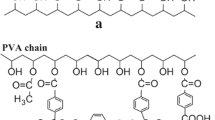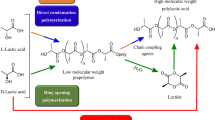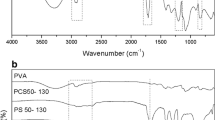Abstract
Fibers of poly(vinyl acetate) (PVAc) homopolymer and ethylene vinyl acetate (EVA) copolymers with varying vinyl acetate (VAc) contents between 25 and 40 wt.% have been prepared to investigate wettability and photophysical properties. At lower VAc contents, it was difficult to prepare fibers without any beads due to the presence of crystalline ethylene groups at higher concentrations. EVA copolymer composition strongly affected the wettability of fibers; all EVA copolymer fibers exhibited superhydrophobic behavior and CA values varied between 150° and 160° depending on copolymer composition while hydrophilic PVAc homopolymer fibers exhibited hydrophobic behavior with a CA of 134°. Photophysical properties of PVAc homopolymer and EVA copolymers were evaluated in terms of transmittance and emission intensity. Emission intensity and transparency of EVA copolymers were decreased with the increase of VAc contents due to its amorphous behavior.

ᅟ






Similar content being viewed by others
References
Iotti RC, Rossi F (2005) Microscopic theory of semiconductor-based optoelectronic devices. Rep Prog Phys 68(11):2533–2571
Hamley IW (2004) Developments in block copolymer science and technology. Wiley, Hoboken
Zhao D, Feng J, Huo Q, Melosh N, Fredrickson GH, Chmelka BF, Stucky GD (1998) Triblock copolymer syntheses of mesoporous silica with periodic 50 to 300 angstrom pores. science 279(5350):548–552
Baudis S, Heller C, Liska R, Stampfl J, Bergmeister H, Weigel G (2009) (Meth) acrylate-based photoelastomers as tailored biomaterials for artificial vascular grafts. J Polym Sci A Polym Chem 47(10):2664–2676
Kahveci MU, Acik G, Yagci Y (2012) Synthesis of block copolymers by combination of atom transfer radical polymerization and visible light-induced free radical promoted cationic polymerization. Macromol Rapid Commun 33(4):309–313
Acik G, Kahveci MU, Yagci Y (2010) Synthesis of block copolymers by combination of atom transfer radical polymerization and visible light radical photopolymerization methods. Macromolecules 43(21):9198–9201
Acik G, Sey E, Tasdelen MA (2018) Polypropylene-based graft copolymers via CuAAC click chemistry. Express Polym Lett 12:418–428
Balsara NP, Park MJ (2006) Block copolymers and nanotechnology. J Polym Sci B Polym Phys 44(24):3429–3430
Balsara NP, Hahn H (2003) Block copolymers in nanotechnology. World Scientific Publishing, Hackensack
Pitto-Barry A, Barry NP (2014) Pluronic® block-copolymers in medicine: from chemical and biological versatility to rationalisation and clinical advances. Polym Chem 5(10):3291–3297
Kabanov AV, Batrakova EV, Alakhov VY (2002) Pluronic® block copolymers as novel polymer therapeutics for drug and gene delivery. J Control Release 82(2):189–212
Jenekhe SA, Chen XL (1998) Self-assembled aggregates of rod-coil block copolymers and their solubilization and encapsulation of fullerenes. Science 279(5358):1903–1907
Gilby G (1982) Developments in rubber technology-3. Applied Science: 101
Tang Y, Hu Y, Wang S, Gui Z, Chen Z, Fan W (2002) Preparation and flammability of ethylene-vinyl acetate copolymer/montmorillonite nanocomposites. Polym Degrad Stab 78(3):555–559
Cavaliere M, Diani E, Vitalini Sacconi L (1993) Polymer modified bitumens for improved road application. Eurobitume Congress, 5th, 1993, Stockholm, Sweden
Loeber L, Durand A, Muller G, Morel J, Sutton O, Bargiacchi M (1996) New investigations on the mechanism of polymer-bitumen interaction and their practical application for binder formulation. Eurasphalt & Eurobitume Congress, Strasbourg, 7–10 May 1996. vol 2. Paper E&E. 5.115
Riva A, Camino G, Fomperie L, Amigouet P (2003) Fire retardant mechanism in intumescent ethylene vinyl acetate compositions. Polym Degrad Stab 82(2):341–346
Allen NS, Edge M, Rodriguez M, Liauw CM, Fontan E (2000) Aspects of the thermal oxidation of ethylene vinyl acetate copolymer. Polym Degrad Stab 68(3):363–371
Liang HW, Guan QF, Chen LF, Zhu Z, Zhang WJ, Yu SH (2012) Macroscopic-scale template synthesis of robust carbonaceous nanofiber hydrogels and aerogels and their applications. Angew Chem Int Ed 51(21):5101–5105
Zelenski CM, Dorhout PK (1998) Template synthesis of near-monodisperse1 microscale nanofibers and nanotubules of MoS2. J Am Chem Soc 120(4):734–742
Xing X, Wang Y, Li B (2008) Nanofiber drawing and nanodevice assembly in poly (trimethylene terephthalate). Opt Express 16(14):10815–10822
Suzuki A, Aoki K (2008) Biodegradable poly (l-lactic acid) nanofiber prepared by a carbon dioxide laser supersonic drawing. Eur Polym J 44(8):2499–2505
Hartgerink JD, Beniash E, Stupp SI (2001) Self-assembly and mineralization of peptide-amphiphile nanofibers. science 294(5547):1684–1688
Zhang S (2003) Fabrication of novel biomaterials through molecular self-assembly. Nat Biotechnol 21(10):1171–1178
Van de Witte P, Dijkstra PJ, Van den Berg J, Feijen J (1996) Phase separation processes in polymer solutions in relation to membrane formation. J Membr Sci 117(1–2):1–31
Liu X, Ma PX (2009) Phase separation, pore structure, and properties of nanofibrous gelatin scaffolds. Biomaterials 30(25):4094–4103
Reneker DH, Yarin AL (2008) Electrospinning jets and polymer nanofibers. Polymer 49(10):2387–2425
Greiner A, Wendorff JH (2007) Electrospinning: a fascinating method for the preparation of ultrathin fibers. Angew Chem Int Ed 46(30):5670–5703
Choi J-K, Hwang I-S, Kim S-J, Park J-S, Park S-S, Jeong U, Kang YC, Lee J-H (2010) Design of selective gas sensors using electrospun Pd-doped SnO 2 hollow nanofibers. Sensors Actuators B Chem 150(1):191–199
Ding B, Wang M, Yu J, Sun G (2009) Gas sensors based on electrospun nanofibers. Sensors 9(3):1609–1624
Gopal R, Kaur S, Ma Z, Chan C, Ramakrishna S, Matsuura T (2006) Electrospun nanofibrous filtration membrane. J Membr Sci 281(1):581–586
Qin XH, Wang SY (2006) Filtration properties of electrospinning nanofibers. J Appl Polym Sci 102(2):1285–1290
Camposeo A, Persano L, Pisignano D (2013) Light-emitting electrospun nanofibers for nanophotonics and optoelectronics. Macromol Mater Eng 298(5):487–503
Chuangchote S, Srikhirin T, Supaphol P (2007) Color change of electrospun polystyrene/MEH-PPV fibers from orange to yellow through partial decomposition of MEH side groups. Macromol Rapid Commun 28(5):651–659
Deitzel JM, Kleinmeyer J, Harris D, Tan NB (2001) The effect of processing variables on the morphology of electrospun nanofibers and textiles. Polymer 42(1):261–272
Lee S, Obendorf SK (2007) Use of electrospun nanofiber web for protective textile materials as barriers to liquid penetration. Text Res J 77(9):696–702
Lee KY, Jeong L, Kang YO, Lee SJ, Park WH (2009) Electrospinning of polysaccharides for regenerative medicine. Adv Drug Deliv Rev 61(12):1020–1032
Sell SA, McClure MJ, Garg K, Wolfe PS, Bowlin GL (2009) Electrospinning of collagen/biopolymers for regenerative medicine and cardiovascular tissue engineering. Adv Drug Deliv Rev 61(12):1007–1019
Boudriot U, Dersch R, Greiner A, Wendorff JH (2006) Electrospinning approaches toward scaffold engineering—a brief overview. Artif Organs 30(10):785–792
Xie J, Wang C-H (2006) Electrospun micro- and nanofibers for sustained delivery of paclitaxel to treat C6 glioma in vitro. Pharm Res 23(8):1817–1826
Taylor SG (1969) Electrically driven jets. Proceedings of the Royal Society of London A: Mathematical, Physical and Engineering Sciences. Roy Soc 313(1515):453–475
Li Y, Zhang Y, Yang D, Feng C, Zhai S, Hu J, Lu G, Huang X (2009) Well-defined amphiphilic graft copolymer consisting of hydrophilic poly (acrylic acid) backbone and hydrophobic poly (vinyl acetate) side chains. J Polym Sci A Polym Chem 47(22):6032–6043
Karacan I, Erdogan G (2012) The influence of thermal stabilization stage on the molecular structure of polyacrylonitrile fibers prior to the carbonization stage. Fibers and Polymers 13(3):295–302
Tasdelen M, Acik G, Yildiran S, Kok G, Salman Y (2017) Synthesis and characterization of sugar-based methacrylates and their random copolymers by ATRP. Express Polym Lett 11(10)
Allan JM, Mumin MA, Wood JA, Xu WZ, Wu W, Charpentier PA (2014) Silica aerogel–poly (ethylene-co-vinyl acetate) composite for transparent heat retention films. J Polym Sci B Polym Phys 52(14):927–935
Sadeghi M, Khanbabaei G, Dehaghani AHS, Sadeghi M, Aravand MA, Akbarzade M, Khatti S (2008) Gas permeation properties of ethylene vinyl acetate–silica nanocomposite membranes. J Membr Sci 322(2):423–428
Yuan X, Zhang Y, Dong C, Sheng J (2004) Morphology of ultrafine polysulfone fibers prepared by electrospinning. Polym Int 53(11):1704–1710
Koski A, Yim K, Shivkumar S (2004) Effect of molecular weight on fibrous PVA produced by electrospinning. Mater Lett 58(3–4):493–497
Wang C, Hsu C-H, Lin J-H (2006) Scaling laws in electrospinning of polystyrene solutions. Macromolecules 39(22):7662–7672
Cengiz U, Avci MZ, Erbil HY, Sarac AS (2012) Superhydrophobic terpolymer nanofibers containing perfluoroethyl alkyl methacrylate by electrospinning. Appl Surf Sci 258(15):5815–5821
Doganci M, Cansoy C, Ucar I, Erbil H, Mielczarski E, Mielczarski J (2012) Combined XPS and contact angle studies of flat and rough ethylene-vinyl acetate copolymer films. J Appl Polym Sci 124(3):2100–2109
Ucar I, Doganci M, Cansoy C, Erbil H, Avramova I, Suzer S (2011) Combined XPS and contact angle studies of ethylene vinyl acetate and polyvinyl acetate blends. Appl Surf Sci 257(22):9587–9594
Cengiz U, Erbil HY (2014) Superhydrophobic perfluoropolymer surfaces having heterogeneous roughness created by dip-coating from solutions containing a nonsolvent. Appl Surf Sci 292:591–597
Cengiz U, Cansoy CE (2016) The effect of pattern sizes on oleophobicity and superhydrophobicity of micropatterned surfaces. Progress in Organic Coatings 101:530–536
Czanderna A, Pern F (1996) Encapsulation of PV modules using ethylene vinyl acetate copolymer as a pottant: a critical review. Sol Energy Mater Sol Cells 43(2):101–181
Rodriguez-Vazquez M, Liauw CM, Allen NS, Edge M, Fontan E (2006) Degradation and stabilisation of poly (ethylene-stat-vinyl acetate): 1–spectroscopic and rheological examination of thermal and thermo-oxidative degradation mechanisms. Polym Degrad Stab 91(1):154–164
Hsiao T-S, Huang P-C, Lin L-Y, Yang D-J, Hong J-L (2015) Crystallization-promoted emission enhancement of poly (l-lactide) containing a fluorescent salicylideneazine center with aggregation-enhanced emission properties. Polym Chem 6(12):2264–2273
Funding
This research did not receive any specific grant from funding agencies in the public, commercial, or not for profit sectors.
Author information
Authors and Affiliations
Corresponding author
Ethics declarations
Conflict of interest
The authors declare that they have no conflict of interest.
Rights and permissions
About this article
Cite this article
Acik, G., Kamaci, M. & Cansoy, C.E. Superhydrophobic EVA copolymer fibers: the impact of chemical composition on wettability and photophysical properties. Colloid Polym Sci 296, 1759–1766 (2018). https://doi.org/10.1007/s00396-018-4395-7
Received:
Revised:
Accepted:
Published:
Issue Date:
DOI: https://doi.org/10.1007/s00396-018-4395-7




